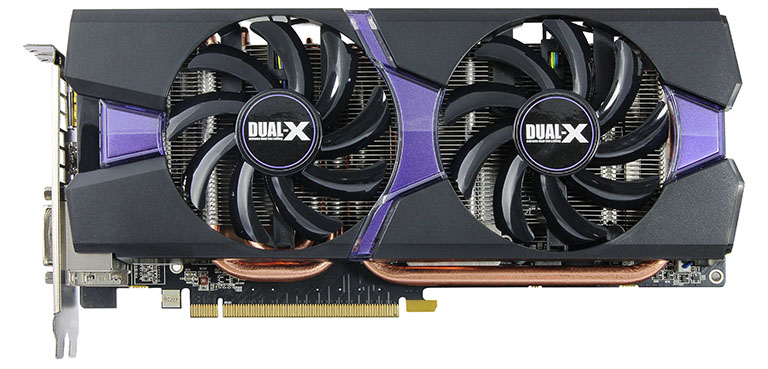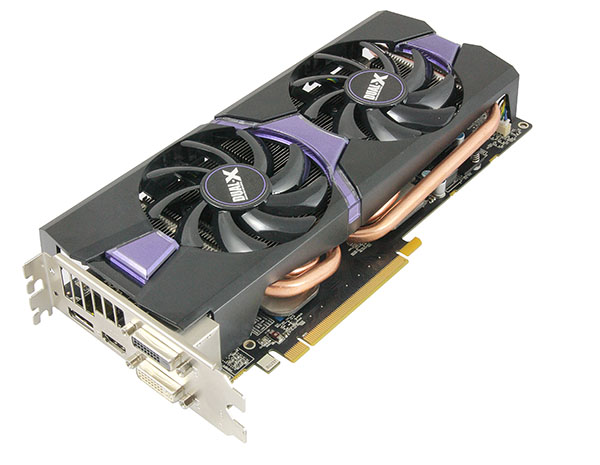Introduction
You may know that the high-end Radeon R9 290X and R9 290 GPUs use the latest Hawaii GCN v2 architecture, imbued with better geometry throughput, tidier design and a general clean-up of the memory controller and back-end when compared to other mainstream Radeon models powered by the first-generation Tahiti architecture. Further improvements stretch to integrating the CrossFire XDMA engine - so no need for external connectors - and adding True Audio support.
But in the context of other premium GPUs, the AMD graphics department has been drinking liberally from the bottle named Rebrand. Let's take the upper-mainstream Radeon R9 280 as an example. Available in March of this year but in fact based almost exclusively on the Radeon HD 7950 graphics processor debuting in January 2012, it's high time AMD evolved the GPU stack and offered consistency from top to middle.
So with the enthusiast segment taken care of by the GCN v2 architecture, AMD is shifting this more efficient design down to premium/mainstream levels. The first implementation of this silicon comes in the form of the Radeon R9 285, offered at $250 and thus supplanting the Radeon R9 280. We line the readily available R9 280X and soon-to-be-retired R9 280 against the new pretender.
| GPU | Radeon R9 280X 3GB | Radeon R9 280 3GB | Radeon R9 285 2GB |
|---|---|---|---|
| Launch date | October 2013 | March 2014 | September 2014 |
| Codename | Tahiti XT2 | Tahiti Pro | Tonga Pro | GCN | GCN v1 | GCN v1 | GCN v2 | DX API | 11.2 | 11.2 | 11.2 |
| Process (nm) | 28 | 28 | 28 |
| Transistors (mn) | 4,300 | 4,300 | 5,000 |
| Approx Die Size (mm²) | 352 | 352 | 359 |
| Processors | 2,048 | 1,792 | 1,792 |
| Texture Units | 128 | 112 | 112 |
| ROP Units | 32 | 32 | 32 |
| GPU Clock (MHz) | 850 | 827 | Unknown |
| Boost clock (MHz) | 1,000 | 933 | 918 |
| GFLOPS (Boost) | 4,300 | 3,344 | 3,290 |
| Memory Clock (MHz) | 6,000 | 5,000 | 5,500 |
| Memory Bus (bits) | 384 | 384 | 256 |
| Max bandwidth (GB/s) | 288 | 240 | 176 |
| Power Connectors | 8+6 | 6+6 | 6+6 |
| TDP (watts) | 250 | 200 | 190 |
| GFLOPS per watt | 17.20 | 16.72 | 17.32 |
| True Audio DSP | No | No | Yes |
| Current MSRP | $299 | $249 | $249 |
Analysis
AMD has taken the range-topping Hawaii architecture powering the R9 290(X) GPUs and cut it down to meet the needs of the $250 market. The R9 285 draws similarities with the R9 280; both have an identical engine room - the same number processors, texture units and ROPs - but part of the the back-end is trimmed by reducing the memory interface to 256 bits. The die size and transistor count - 5.0bn and 359mm² - are larger than the Tahiti-powered GPUs, and this is a little surprising given that AMD has limited the bus width on the Tonga silicon. It's reasonable to assume this new GPU has more on-chip cache and, maybe, AMD isn't telling us everything contained within the die. A Tonga XT GPU might shed more light onto why the silicon is larger than expected.
A consideration of the frequencies shows R9 285 to have about as much shader power as the R9 280 (Radeon HD 7950 Boost, in other words) yet considerably less memory bandwidth, which is an important factor once lots of pixels are thrown around. Making matters worse, on paper at least, the standard memory configuration is reduced from 3GB to 2GB. The new GPU, therefore, is hamstrung in the memory department when compared against its predecessor.
Shouldn't this be slower?
It would perhaps be sensible to imagine the R9 285 being slower than the card it replaces, especially at higher resolutions accompanied by lots of eye candy, but AMD is banking on the efficiencies of the Tonga/Hawaii architecture to come to the fore and mitigate on-paper losses.
In particular, Tonga claws performance back by utilising a much-improved geometry/tessellation setup at the front-end of the GPU and ameliorates the memory-bandwidth advantage, in some cases, by storing colour data in a lossless format, leading to, AMD says, 40 per cent higher memory-bandwidth efficiency in some tests. This compression is unique to Tonga, and not available on the R290(X) GPUs. Tonga, too, has a new media-processing block, designed for faster transcoding from 4K sources. So while the raw numbers don't look quite as impressive as R9 280, real-world performance should be fairly close, with exact performance differential dependant upon the game engine.
We find the Radeon R9 285 interesting because, for the first time, we can reasonably compare the two GCN architectures side by side. The $250 (£170) price point brings Nvidia's GeForce GTX 760 processor very much into play, deliberately so, and all cards bunched in this area need to excel at providing super-smooth gameplay at a 1080p resolution.
AMD contends that anyone looking to upgrade their present graphics card in order to play the latest games at a full-HD resolution with eye candy turned to maximum ought to take notice of the Radeon R9 285. In a strange move, AMD already announced the GPU last week, and we have a Sapphire Radeon R9 285 Dual-X OC in for review today.
A retail card
Sapphire knows the R9 285 GPU requires less cooling than the R9 280 that has been doing the rounds of late. Thinking about overclocking and ensuring that higher TDPs are catered for, the same Dual-X cooler is repurposed from that model and used here. Measuring 10.5in (262mm) long and presented in the usual dual-slot form factor, Sapphire also includes thermal pads for the memory chips and, probably more importantly, has a small heatsink covering the VRM components situated directly below the right-hand fan.
Two 85mm fans sit on top of four heatpipes - two thick (8mm), two thin (6mm) - that run into a copper base which makes contact with the core. Power is sourced by dual six-pin power connectors located on the far side. One notable difference between the two Dual-X OCs is the lack of CrossFire connectors on this PCB. Rather, as alluded to earlier, the new GPU technology integrates the XDMA engines right onto the silicon itself. One aspect of potential importance here relates to how these cards operate in an Intel X99 platform, particularly for the Core i7-5820K processor equipped with 28 PCIe lanes. Understanding that XDMA engines use the internal PCIe bandwidth, two GPUs may not run at absolutely full speed on that configuration.
We know the cooler has no problem taming GPUs with higher power ratings. Sapphire uses this headroom to raise the peak GPU core speed from 918MHz to 965MHz. Memory, meanwhile, is also given a little boost, from 5,500MHz to 5,600MHz.
Plumbed with the usual quartet of two dual-link DVI, HDMI and DisplayPort, four outputs can be run at one time. In fact, six screens can be used if you invest in a DisplayPort Multi-Stream Transport hub. Three-screen Eyefinity technology therefore works without having to use the DisplayPort connector, meaning that the trio of right-hand outputs can be loaded at once. 4K resolutions, too, are supported via DisplayPort 1.2 at 60Hz and HDMI 1.4a at 30Hz.
To coincide with the Radeon R9 285, AMD is updating the Never Settle gaming bundle. Now referred to as the Space Edition, there's a wider range of titles to choose from. Back on track, Sapphire expects this card to retail for approximately £175 from today. This price puts it firmly within striking distance of the GeForce GTX 760, so let's set about comparing the two.












